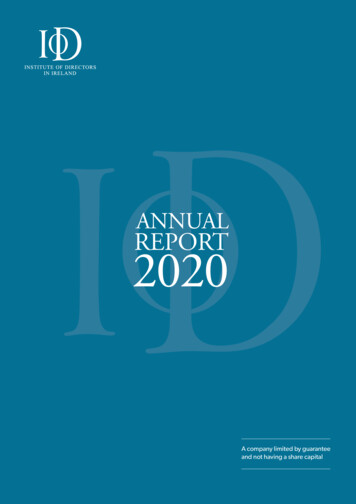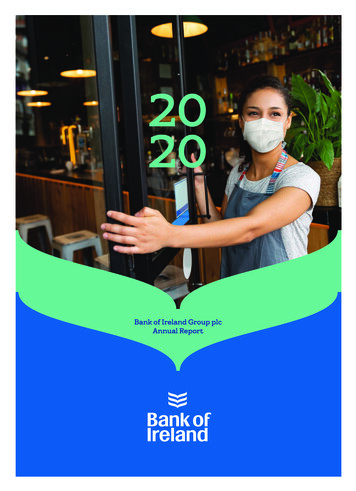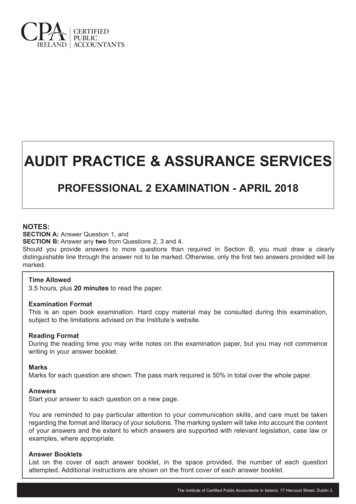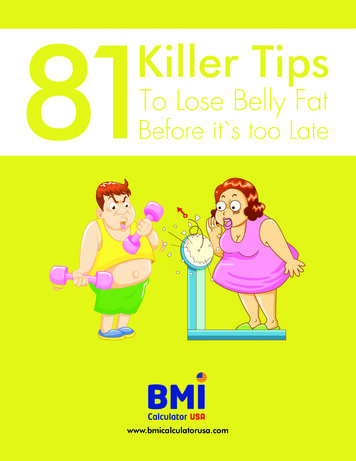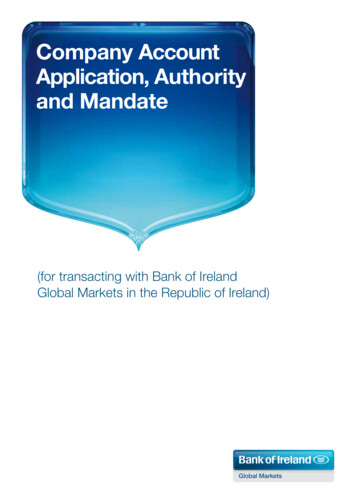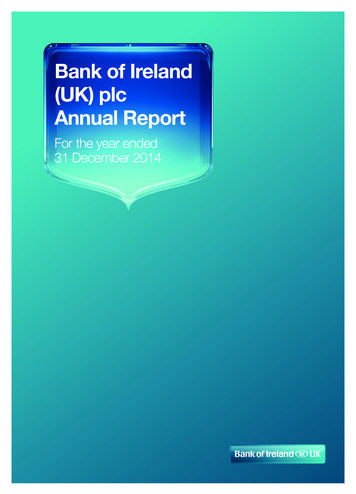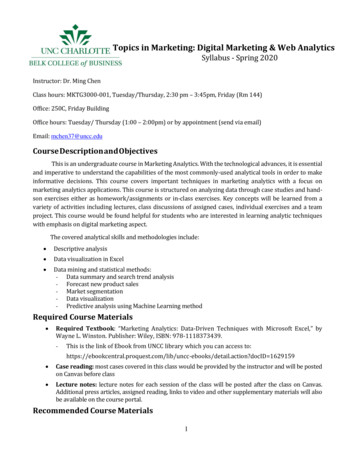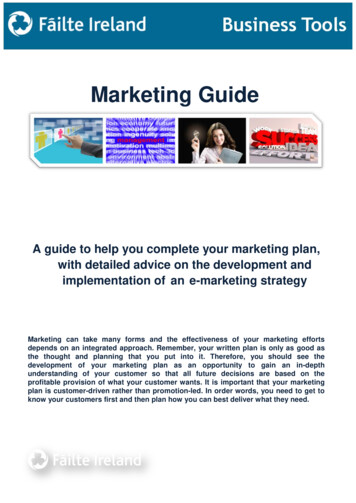
Transcription
Marketing GuideA guide to help you complete your marketing plan,with detailed advice on the development andimplementation of an e-marketing strategyMarketing can take many forms and the effectiveness of your marketing effortsdepends on an integrated approach. Remember, your written plan is only as good asthe thought and planning that you put into it. Therefore, you should see thedevelopment of your marketing plan as an opportunity to gain an in-depthunderstanding of your customer so that all future decisions are based on theprofitable provision of what your customer wants. It is important that your marketingplan is customer-driven rather than promotion-led. In order words, you need to get toknow your customers first and then plan how you can best deliver what they need.
Table of ContentsQ).t.Introduction . 3Step 1 - Examine your Business as it StandsMarket Trends Analysis . 7Local Market Review. 9Review your Web Presence . 10 Website Effectiveness . 10 Website Audit . 13Sources of Business Revenue . 15Customer Review . 16Competitor Review . 17SWOT Analysis . 19Strategic Options . 21Step 2 - Develop your Marketing StrategySetting Marketing Objectives . 22Customer Segmentation and Targeting . 23 Developing Personas . 24Positioning Your Offering . 26Pricing . 27Distribution Channels / Routes to Market Working with Partners . 30 Packaging Your Products . 31 Targeting the Overseas Markets. 31 Trade shows . 32 E-marketing and Selling to your Customer . 33 Search Engine Optimisation . 33 Social Media – Facebook and Twitter . 35Communication Channels Developing a PR strategy . 42 Choosing Advertising Media . 44 Organising a Pay-per-Click Campaign . 45 Using Google Adwords . 46Budget . 47Marketing Planning Template by Segment . 48èStep 3 - Implement and Monitor for SuccessWrite the Plan. 49Put Your Plan into Action . 49Action Plan . 51Marketing Health Check . 53Appendix - Some useful templates . 55Fáilte Ireland supports . 76
IntroductionMarketing has never been more crucial to success, nor more challenging to tourism industrymanagers. Fáilte Ireland, the National Tourism Development Authority, provides a range of services toassist tourism businesses in optimising the effectiveness of their marketing strategies. This MarketingGuide is designed to provide a template for the development of an integrated Marketing Plan whichincludes significant e-commerce activity.Marketing can take many forms and the effectiveness of your marketing efforts depends on anintegrated approach. Remember, your written plan is only as good as the thought and planningthat you put into it. Therefore, you should see the development of your marketing plan as anopportunity to gain an in-depth understanding of your customer so that all future decisions are basedon the profitable provision of what your customer wants. It is important that your marketing planis customer-driven rather than promotion-led. In order words, you need to get to know yourcustomers first and then plan how you can best deliver what they need.The Guide takes a holistic view of your marketing strategy. It will support you in completing yourplan and offers detailed advice on the development and implementation of an e-marketingstrategy with reference to web development, search engine optimisation and social networkingopportunities.This Guide is also accompanied by a marketing planning template. Such a ‘step by step approach’ willassist you in completing a comprehensive and useful plan for your business.It is important to remember that planning is an inclusive process so it is recommended that you donot ‘go it alone’ and that you consult your team where appropriate. Your plan will be useful for you andalso for key stakeholders including staff, directors and investors in order to achieve a sound businessfooting for the future.The plan is divided into 3 steps which answers 3 key questions.Step 1: Examine your business as it standsWhere are we now?Step 2: Develop your marketing strategyWhere do we want to be?Step 3: Implement and monitor for successHow are we going to get there?
Before you can set out your objectives for the year(s) ahead, you need to find out what’s happening inthe market place and how fit your business is to meet the challenges for the year(s) ahead. This helpsyou to answer the key question: where are we now?To answer that question you need to research the key trends in your sector, find out how youperform relative to your competition in the eyes of the consumer and you need to figure out whatyour key strengths and weaknesses are. This will help you to do a good SWOT (Strengths, Weaknesses,Opportunities and Threats) analysis.The business environment in which we operate is also a significant factor in getting an objective viewof where a business stands. Managers and operators of tourism businesses are acutely aware thatthey must compete strongly for every euro of revenue. So what does this all mean for yourparticular business? Can you see opportunities out there that need to be explored?Where do we want to be? Having answered the first question- ‘Where are we Now?’, you are in abetter position to decide where you want your business to be next year and beyond. You are able todecide your strategy based on the facts and you can set objectives to help your business survive orrefocus.How are we going to get there? In this final part of the plan you are ready to implement yourstrategy to achieve your objectives. Your key for survival is your customers so this part of the plan focuseson how you can retain or even attract additional customers.Please see the planning framework overleaf which provides an overview of how this Guide and themarketing planning template are structured.
YOUR PLANNING FRAMEWORKStep 1: Examine your Business as it Stands Where are we now?Market TrendsAnalysis Customer &Sources ofBusiness Revenue Competitor ReviewWeb PresenceReviewLocal MarketReview www SWOTDEFEND MARKET SHAREYOURSTRATEGICOPTIONSMARKET PENETRATION/NEW MARKETSGROWTHPRODUCT / SERVICE INNOVATIONMOVE INTO DIFFERENT MARKET SECTORStep 2: Develop your Marketing Strategy - Where do we want to G &POSITIONINGSELECT / REFINEPRODUCTS, PRICING,COMMUNICATIONAND DISTRIBUTION CUSTOMERRETENTION &ATTRACTIONStep 3: Implement & Monitor for Success- How are we going to get EASURING
STEPSStep 1YOUR MARKETING PLANExamine your businessas it standsWhere are we now?Step 2Step 3ACTIONS REQUIREDAnalyse Market TrendsReview Local MarketReview Web PresenceConduct a Website AuditAnalyse Sources of RevenueUndertake a Customer Reviewand Competitor Review Undertake a SWOT Analysis Where do we want to be? Set Marketing Objectives Segment, Target and Positionyour Offering Sell to your Customers and UseE-Marketing Tools Manage Communications andthe Media Choose a Pricing and Routes toMarket StrategyImplement and monitorfor success Putting Your Plan into Action Action Plan Marketing Health CheckDevelop yourmarketingstrategyHow are we goingto get there?
Step 1: Examine Your Business As It Stands.Where are we now?Market Trends AnalysisMarket TrendsAnalysisLocal MarketReview Customer &Sources ofBusiness Revenue Competitor ReviewWeb PresenceReview www SWOTThis section will present an overview of the current situation for the business and the market inwhich the business operates.Write up a brief description of how the market is performing now and how it is forecast toperform over the coming year. Refer to a range of sources including tourism andaccommodation statistics and forecasts from Fáilte Ireland and Tourism Ireland, CroweHorwath, Central Statistics Office (CSO), Mintel, Irish Tourist Industry Confederation (ITIC),industry websites etc. Comment on how these trends will affect your business.Question to ask yourself. For example, if this year indicates a fall of10-15% in a particular segment (e.g. leisure customers), how realistic is itfor you to propose an increase for this segment next year? These are thetypes of questions to start asking yourself
Step 1Step 1As highlighted in the recent ITIC report ‘ A Changed World for Irish Tourism – Facing up to theChallenges of Recovery’ recovery will depend on restoring growth from the top 4 overseas sourcemarkets i.e. Britain, USA, Germany and France, with these markets typically producing three out ofevery four holiday visitors to Ireland. The British market is considered to offer the best opportunityfor growth and is regarded as very important to Ireland’s tourism recovery. The size of thepotential market in Britain, coupled with a common language and close proximity to Ireland,dictates the need to regain market share. Germany is also viewed as offering a lot of potential the industry view is that Ireland is well positioned in Germany and has in place well establishedtrade links in a market where the travel trade is still dominant. The US market is also regarded asoffering potential for recovery and growth based on the current demand patterns of an upturn intravel to Europe. The high spending American tourist is critical for many businesses in Ireland.However, the single largest perceived risk to renewed growth would be the lack of adequate airaccess with competitive fares. Incentive travel and conferences for the US market are expected toprovide further potential for Ireland. France is viewed as offering further potential and likeGermany is especially important to tourism businesses and is reckoned to offer some goodpotential to exploit niche opportunities.The priority markets for promotable business travel (MICE) are identified as Britain, USA andGermany. This sector is regarded as worthy of particular attention due to its high value, yearround potential, while the opening of the Convention Centre Dublin (CCD) offers an opportunity tocapture an increased market share. Other markets such as Italy, Spain, the Netherlands and theNordics, coupled with Australia and the emerging long-haul markets will continue to offeropportunities for Ireland.What to do for your business.Collect information about what is happening in your sector, what new products or services arebeing developed. Find out about new products / services in the market by reviewingcompetitor websites (especially overseas), speak to suppliers, or search for a relevantconference or trade show you can attend. Consider all the changes in your sector over the last fiveyears and imagine what can happen in the next five as the pace of business change accelerates.Question to ask yourself. Are there markets such as Germany,France, UK or the USA that could be further explored as potentialmarkets for your business? What markets should you be targeting? Doyour products match the markets?
Step 1Local Market ReviewMarket TrendsAnalysisLocal MarketReview Customer &Sources ofBusiness Revenue Competitor ReviewWeb PresenceReview www SWOTOpportunities and Threats in your Catchment AreaOutline the significant changes in your local market, such as competitor developments. List anybusinesses opening
development of your marketing plan as an opportunity to gain an indepth - understanding of your customer so that all future decisions are based on the profitable provision of what your customer wants. It is important that your marketing plan is customer-driven rather than promotionled. In order words, you need to get to - know your customers first and then plan how you can best deliver what .

